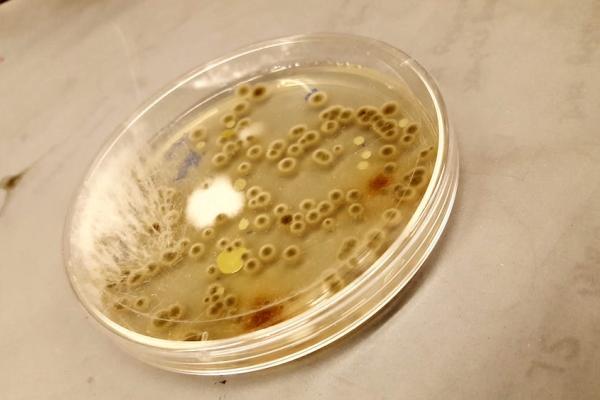
GCB has teamed up with the Center for Applied Genomics and Precision Medicine (CAGPM), the Pratt School of Engineering and the Department of Molecular Genetics and Microbiology (MGM) on the Blue Devil Resistome Bass Connections project.
Fourteen undergraduates, led by GCB member and Paul Ruffin Scarborough Associate Professor of Engineering, Lingchong You, Ph.D., are exploring and mapping the distribution of antibiotic resistant bacteria on Duke Campus. Other faculty advisors include Associate Professor in Population Health Sciences, Susanne Haga, Ph.D.; Directory of CAGPM and MEDx and Professor of Medicine, Geoff Ginsburg, M.D., Ph.D.; Vice Dean of Basic Science and Professor of Molecular Genetics and Microbiology, Raphael Valdivia, Ph.D.; and Theodore Kennedy Associate Professor of Civil and Environmental Engineering, Claudia Gunsch, Ph.D.
 The undergraduate students have been split into two groups: an experimental team, led by third-year MGM graduate student Jonathan Bethke, and a computational team, led by fourth-year biomedical engineering graduate student Carolyn Zhang. “We are evaluating the microbiome of Duke and how resistance spreads and fluctuates in the environment,” Bethke said. Since summer, the experimental team has been collecting environmental samples from buildings, printers, garden benches, the gym, and a host of other locations.
The undergraduate students have been split into two groups: an experimental team, led by third-year MGM graduate student Jonathan Bethke, and a computational team, led by fourth-year biomedical engineering graduate student Carolyn Zhang. “We are evaluating the microbiome of Duke and how resistance spreads and fluctuates in the environment,” Bethke said. Since summer, the experimental team has been collecting environmental samples from buildings, printers, garden benches, the gym, and a host of other locations.
They started with ten sites and have expanded to 20. Students helped choose these sites based on where they were every day and what sites they were interested in testing. They selected a diverse set of sites but also sites that they could easily compare. “We could look at the men’s bathroom versus the women’s bathroom, or the inside of the bathroom door handle versus the outside,” Bethke said. They also looked at a bench located in the Duke gardens, different elevator buttons, and a variety of places in both West and East campus.
The team has started analyzing some of their data, and they’ve found some interesting results. The lowest proportions of antibiotic-resistant bacteria were found in a women’s bathroom and West Union; conversely, a bench in the Duke Gardens has consistently had the highest proportion of antibiotic resistant bacteria of all of their sampling sites. “We would expect a relatively high microbial load on regions outside and closer to the garden,” Bethke said. “We did not expect such a high proportion of antibiotic resistance in a more natural environment, though.” However, such results must be taken with a grain of salt--it’s hard to attribute these findings to anything in particular. They stressed the importance of long-term measurements to establish a consistent baseline for each site.
 The computational team is releasing the information the experimental team finds to the general public. They are creating a database that will be easy for the lay-person to understand, which will allow people to delve into scientific research on their own and learn what these findings mean for their health. “We will have interactive maps users can look at over time and examine different growth conditions,” Carolyn Zhang said. As antibiotic resistance continues to grow globally, the hope is that greater awareness of the good and bad microbes around us will facilitate measures aimed to prevent infection.
The computational team is releasing the information the experimental team finds to the general public. They are creating a database that will be easy for the lay-person to understand, which will allow people to delve into scientific research on their own and learn what these findings mean for their health. “We will have interactive maps users can look at over time and examine different growth conditions,” Carolyn Zhang said. As antibiotic resistance continues to grow globally, the hope is that greater awareness of the good and bad microbes around us will facilitate measures aimed to prevent infection.
The team is just getting started. Currently, they are only testing resistance to one of the most commonly used antibiotic classes, beta-lactams. The thought is that bacteria resistant to beta-lactams will likely be resistant to other antibiotics as well. Through follow-up analysis, they will be able to test other antibiotic resistances.